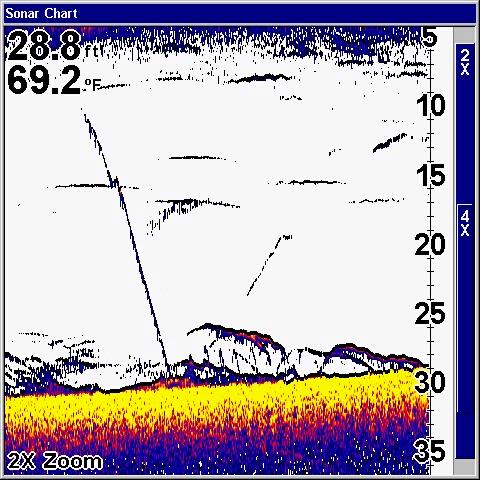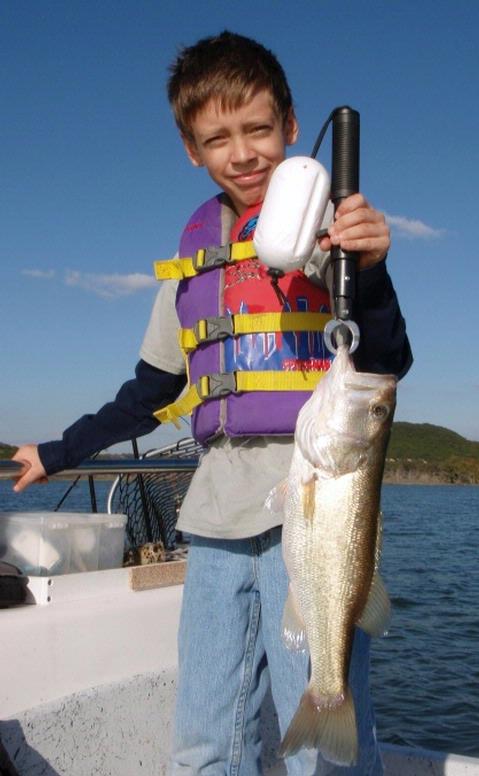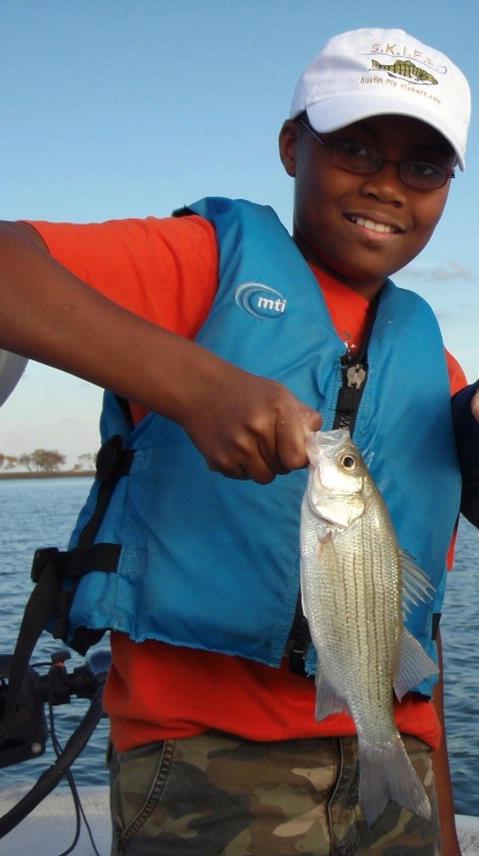If you own a sonar unit and don’t know how to use it, don’t have confidence in interpreting what you are seeing, or don’t know how to adjust your unit, the time to get on the water is now. If you don’t own a sonar, and plan to get one for Christmas, the time to get on the water is now. I can show you how to make the most of your sonar and will even send you home with a listing of the best setting for your unit, all while catching solid numbers of white bass.

THIS SONAR SCREEN IS SCREAMING “GOOD FISHING!!” If you couldn’t quite tell that just by looking, you should come out and learn to read sonar while catching fish at the same time. This time of year lends itself to many “shots” at sonar-spottable fish on any given trip.
What’s happening right now is this: The water temperature is dropping slowly, and the fishes’ metabolism is decreasing as well. The fish group more tightly and move less frequently then during the hot months, all the while feeding on shad that are also slowing down and bunching up. White bass consume most of the protein that goes into egg and sperm development for the Spring spawn beginning now. With cool weather and deer season upon us, the lakes are underutilized — it’s just a great time to be out. Here’s what happened today…
Start Time: 6:40a
End Time: 11:00a
Air Temp: 63F at trip’s start.
Water Surface Temp: ~67.5F
Wind: Winds were due ENE at 6-10 mph.
Skies: Skies were 100% grey and heavy.
As I launched, the winds had a ENE bearing — usually not a good sign, but, they were damp, warm winds, not driven by cold front conditions. This was a good sign.
I looked for any natural sign to clue me in to fish location, but found little. I headed first to Area 443 and found sparse, scattered, small suspended white bass here. I caught 1 and had several more fail to respond positively and thought I’d be in for a tough morning.
I then noticed some surface activity at between Area 537 and 538 (BA-2HG/1O) and over 21 to 29 feet of water. I stealthily pulled up on this activity and went to work with a cork rig and very quickly put 16 small white bass in the boat beginning around 7:30. I stayed on this area until exactly 9:03 when, after catching my 70th fish of the trip (69 whites and 1 short largemouth), I decided to leave these fish as they were still active in order to try to pin down the location of additional active fish for future reference. These fish responded equally well to a jigged slab, a lift-dropped slab, and a smoked slab after the topwater died off, and in both the 3/8 and 1/2 oz size TNT 180. This is the first time this fall I’ve had fish willing to hit the larger 1/2 oz. profile. Had I brought a Hazy Eye Shad Rig, doubles would have certainly been possible given the high activity level of these fish. The size of these fish was solid. Most topwater and suspended fish were smallish, but all bottom-hugging fish were at least legal, with many going 13+ inches. The largest white bass today was 14 1/8 inch.
I checked a few areas, but failed to find bait at most, Area 088 being one exception. This area had a bit of bait holding near bottom in 36′. Once I got a slab down there, I raised one school of about a dozen fish, but little else.
I moved on and wrapped up the trip at Area 539. There is a well-defined slope here and the fish and shad were holding off the face of the slope at the 29-32 foot mark. These fish would not respond to the 1/2 oz. slab, as the activity level was falling off rapidly. I caught 11 fish here (10 whites and a 16.5 inch largemouth), 2 struck off bottom, and the rest came out of very stationary suspended groups of 2-3 fish. By 11:00a, the fish would simply not respond any longer, despite still being suspended slightly off the bottom. I packed it up at this point and headed in.
TALLY = 81 fish, all caught and released



